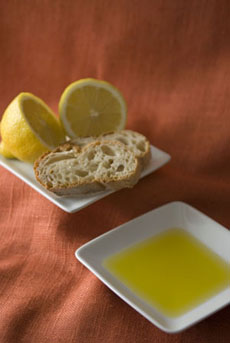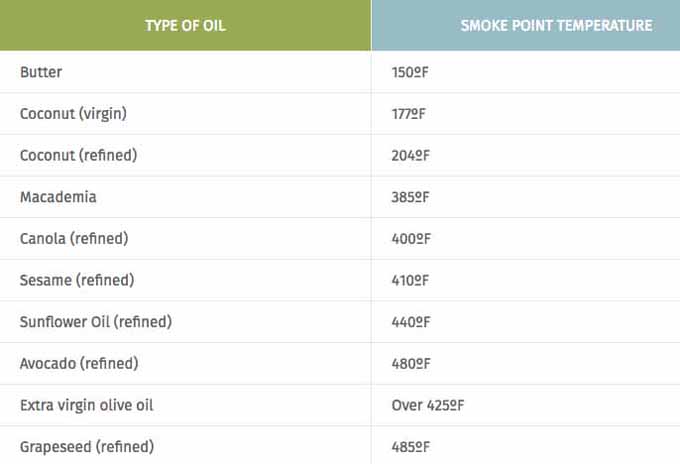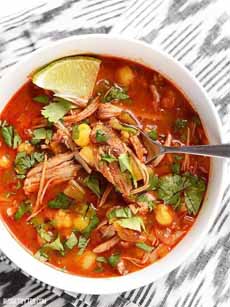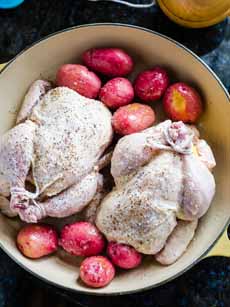|
It’s the month of good eating resolutions. One of the easiest to follow: add more salads.
Whether it’s a main salad or a side salad, just avoid creamy dressings, stick to vinaigrettes, and you’re set.
One of our favorites is a Greek Salad, so here are some ways to approach it—and get creative ideas for your own favorite salad(s).
Note that while in the U.S. many restaurants serve the Greek salad with romaine lettuce. Lettuce doesn’t grow well in Greece, so at Greek restaurants, an authentic Greek salad, horiatiki, is served without it.
CLASSIC GREEK SALAD WITH SPIRALIZED CUCUMBER
This salad (photo #1) has classic ingredients with a variation in texture: Get out your spiralizer and spiralize the cucumbers, instead of slicing them.
It adds a fun element with different texture that leads to a slightly different taste experience. Be sure to drain the spiralized cucumbers on paper towels to keep water out of the salad.
Other salad vegetables to spiralize—and one fruit—are apple, beet, bell pepper, carrot, red onion and zucchini/yellow squash.
What about tomatoes? hard to find decent tomatoes in the winter, so look to cherry tomatoes or sundried tomatoes, plumped up in olive oil.
Thanks to The Pampered Chef for this recipe.
Ingredients For 8 One-Cup Side Servings Or 3-4 Main Salads
For The Dressing
2 tablespoons (30 mL) fresh lemon juice
2 tablespoons (30 mL) red wine vinegar
½ teaspoon (2 mL) dried oregano leaves
1/8 teaspoon (.5 mL) each salt and black pepper
1 garlic clove, pressed
2 tablespoons (30 mL) extra virgin olive oil
For The Salad
2 English cucumbers, cut in halves or thirds
1 small red onion (or ½ medium onion), peeled and ends trimmed
1 pint (2 cups/500 mL) cherry tomatoes
1 jar (7.5 oz/212 g) marinated artichoke hearts, drained and coarsely chopped
¼ cup (50 mL) Kalamata olives, pitted and halved, or pitted ripe olives, sliced
4 ounces (125 g) crumbled feta cheese
Garnish: oregano
Optional garnishes: anchovies, pepperoncini
Preparation
1. MAKE the dressing: Whisk together all the ingredients and set aside.
2. SPIRALIZE the cucumbers. Snip the cucumber noodles occasionally to shorten the strands. Place the cucumbers on paper towels and blot any excess moisture. Allow the excess water to drain prior to assembling the salad.
3. SPIRALIZE the red onion, then cut the spirals in half. Rinse the spirals under water to remove the bite. Drain and set aside.
4. SLICE the tomatoes in half. Combine the cucumber, onion, tomatoes, artichoke hearts, olives, and cheese in a large bowl. Toss to combine.
5. DRIZZLE the mixture with half of the salad dressing and garnish with oregano. Serve the remaining dressing on the side.
Italian Variation
The two neighboring peninsulas share a number of ingredients, including artichokes, olives and oregano. Their cheeses are different, though, so:
ADD 1 ounce (30 g) finely grated Parmesan cheese to the dressing.
SUBSTITUTE Castelvetrano olives for the Kalamata olives
ADD 3 ounces (90 g) salami, cubed
SUBSTITUTE 4 ounces (125g) ciliegine (cherry-size fresh mozzarella balls), cut in half, for the feta
MORE GREEK SALAD RECIPES
Authentic Greek Salad Recipe
Greek Salad With Fries & Tzatziki
Greek Salad Variations
Plus
Greek Potato Salad
How To Choose Feta Cheese
>>>HERE’S THE HISTORY OF GREEK SALAD<<<
>>>HERE’S THE HISTORY OF SALAD IN GENERAL<<<
|
|
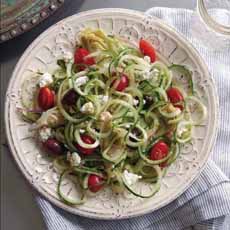
[1] Spiralize your cucumbers, zucchini, carrots, etc. (photo and recipe courtesy The Pampered Chef).
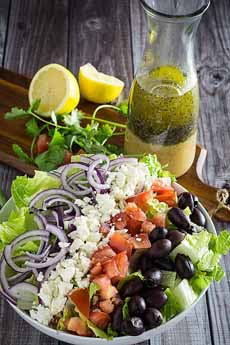
[2] Adapt the style of another favorite salad, the Cobb Salad. Here, the Greek Salad ingredients—feta, olives, onions, tomatoes—substitute for traditional Cobb ingredients—avocado, bacon, hard-boiled eggs and roquefort cheese (photo courtesy The Tuck Rooom | L.A.).
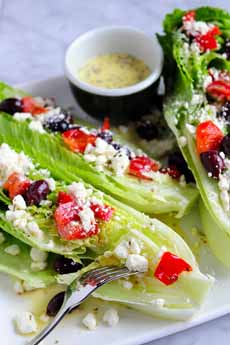
[3] Make your salad sliceable: Use romaine “boats” as the base to be covered with the other ingredients (photo courtesy DeLallo).
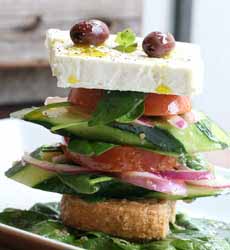
[4] Get fancy with this vertical—horiatiki is a Greek salad without the lettuce. The word means village salad or rustic salad (photo courtesy Death Ave | NYC).
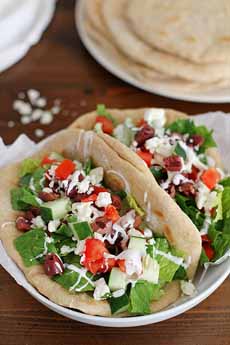
[5] Familiar ground: Greek salad in a pita. Here’s the recipe from Girl Versus Dough, using homemade pita.
|

